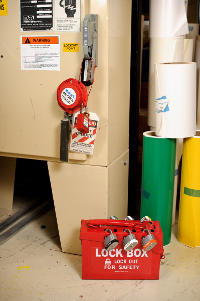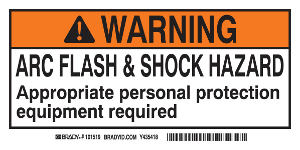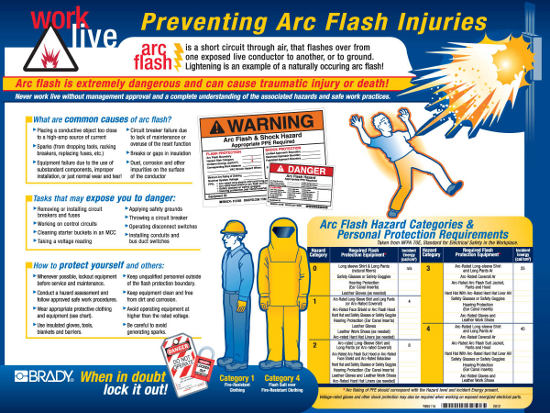With an increase in accidents and injuries occurring in a variety of industries, employers are looking for ways to reduce hazards and improve safety within their facilities. Even with a plethora of information available to supervisors, the inundation of all of these safety recommendations can be overwhelming and can result in even the most basic of mistakes. If you or your employees can relate, it is important to go back to the basics and review the most common issues contributing to electrical risks within facilities.
1. De-energize all equipment before working on it.

The most surefire way to eliminate electrical hazards is to de-energize equipment before working, testing, or repairing systems. Many additional components that will be discussed throughout increase protection or reduce incidents, but electrical hazards can still pose a risk if you do not de-energize. Until equipment and systems are placed in an electrically safe working condition, electrical hazards pose an extremely high risk.
A reported 80% of electrical injuries within the United States could have been avoided if equipment was powered down or de-energized and locked out prior to completing any tasks. Some of the most common reasons that employees and employers continue to work with energized equipment is to avoid paying overtime, to avoid slowing down production, or just because it seems inconvenient and takes too long. By choosing to mandate that equipment be de-energized, employers are reducing the number of electrical liabilities in their facility and putting employee safety at top of mind.
2. Update and test your equipment.
In addition to making sure electrical equipment is properly locked and tagged out before use, it is also critical to make sure equipment is up-to-date and safe for use. According to NFPA 70E standard 110.9(A)(1) Use of Equipment, Rating, instruments, equipment, and their accessories need to be tested and rated for the circuit to which they will be connected. Make sure that all cords have good insulation and proper coding to meet voltage, wire size, and conditioning requirements.
Key examples of types of situations and equipment that need to be regularly updated and tested include:
Installation of conduits and bus duct switches Working on control circuits Cleaning starter buckets in a motor control center (MCC) Applying safety grounds Operating disconnect switches and breakers Taking a voltage reading Removing and installing circuit breakers or fuses Inside the flash protection boundary.
3. Identify your wires correctly.
Being able to quickly identify the wires and cables at your location is critical so that the essential information is available to employees at the point of need. Proper labeling and schematics make several workplace activities more efficient and effective. Moves, adds, changes, and troubleshooting efforts are all simplified by a quality identification program. Proper electrical system identification can significantly reduce labor costs associated with most maintenance or upgrade projects. With such a variety of wires, labels, sleeves, and tags available, it is easy to create legible identification, but it is also easy to inconsistently identify your wires with the incorrect label materials. If you are unsure what type of wires to use, consult a third party organization that specializes in wires. They will be able to outline the myriad of options available for identification solutions based on your application.
It is important to consider when the wires need to be labeled, the size of the label needed, and the type of environment where the label will be placed. When it comes down to incomplete wiring identification, you are not only wasting time and resources, but you are opening the door to an electrical hazard and injury. Understanding the environment your markers will need to withstand is crucial to ensure they meet the desired requirements. Using poor quality labels can create bigger issues in the future and reduce productivity, performance, safety and security within your facility.
4. Wear appropriate safety gear.
A key component in the prevention of electrical hazards is ensuring employees have the right clothing and PPE to work on potentially hazardous equipment. Some employees forego the heavy, stiff arc-rated gear because of discomfort. While PPE equipment and proper clothing can be hot, uncomfortable, and typically requires additional preparation, it saves lives and prevents injury if an electrical hazard were to occur.

Before purchasing PPE and arc-rated clothing for your facility, you must first conduct an arc flash analysis to ensure the clothing is appropriate for the amount of energy that correlates with the tasks to be performed. Protective clothing can range from a category 0 up to a category 4. The category rating helps determine how much protective gear is required, even in situations when an employee is “simply troubleshooting.”
Most individuals who work on common electrical equipment only require clothing that meets category 1 or 2, while NFPA 70E electrical standards are aimed more toward employees who work on more hazardous pieces of equipment and need to wear category 3 or 4 hazard classifications of clothing. Proper safety gear includes gloves, headgear, footwear, eyeglasses, coveralls, hearing protection or other tools. It is also extremely critical for employees to be aware of the life-span or expiration date of materials. This can help eliminate using clothing that is worn out or has been damaged.
5. Don’t use generic arc flash labels!
Within the industry, electrical shock is the second leading cause for lost time on the job, so a main priority should be to keep employees safe from electrical hazard. It is essential to inform employees about electrical hazards in order to keep them out of harm’s way. The best and most effective way to prevent arc flash and other electrical hazards is to display visually instructive labels and signs that communicate hazards and warning messages.
You should also ensure that all of your arc flash labels meet the labeling requirements outlined in the 2012 NFPA 70E. Prior to 2009, it was not specified by NFPA or OSHA that it was necessary to have equipment-specific arc flash labels with detailed hazard information in the facility. When the NFPA updated its standards in 2012, they were modified to require specific elements that needed to appear on the label in reference to the piece of equipment that the label identifies. It is extremely important not to fall privy to the ease of using generic arc flash labels that were created years ago. If you are currently using generic labels, you must take the time to re-label and reclassify each piece of equipment, not only to comply with NFPA standards, but also to ensure clear and concise communication for your employees.
6. Take personal safety into your own hands.
With many employees working throughout the plant, don’t ever rely on someone else to ensure your safety. If there is ever an instance when you are unsure if a circuit has been checked or you just are unsure how to perform a task, be proactive. Check the circuit yourself or ask an authoritative supervisor. You are more likely to prevent injury and accident by relying on your own safety protocols than to put the trust in others. Gain control of the situation and take personal safety into your own hands.
7. Maintain training and education.

Failing to train employees on the proper way to work on electrical equipment doesn’t just result in OSHA fines but could result in serious injury. Many tasks require specialized training that can help prevent confusion and injury. It is very important that all tasks performed throughout the facility are handled by trained personnel using appropriate tools and PPE. Without proper training and guidance, employees may not be aware of protocols and proper handling of an electrical hazard.
It is also imperative to stay updated on pertinent regulations, standards, and any changes or updates that are made to those regulations and standards. Many people fall under the impression they can meet the minimum requirements by following only one of the electrical safety standards. However, it’s not enough to maintain compliance and safety. Making sure that you and your facility are compliant with all electrical safety standards as well as OSHA’s regulations will keep your employees safe and your facility in compliance. Stay informed on regulations and industry trends and make sure to communicate any new information to co-workers.
In addition, if you are the individual who conducts the electrical training session at your facility, make sure to keep it concise and engaging in order to reduce disinterest and attentiveness. Many third-party companies offer comprehensive on-site or online training services to ensure all of the proper information is communicated, while keeping the employee engaged.
Taking these basics into account when labeling, training, and organizing your facility will help provide a strong foundation for a safer work environment. Even though we are instructed to learn the basics on day one, it is essential to refresh and remind ourselves that the basics bring stability and confidence in the attempt to eliminate all electrical and safety hazards.
While many injuries are caused by human error, you can still work to avoid arc flash and electrical hazard accidents. By completing regular scans and analysis of equipment, work practices, and safety training programs, you are taking the extra steps to reduce equipment failure, loose connections, and ensure that you are helping to safeguard your workers from a hazardous injury.
